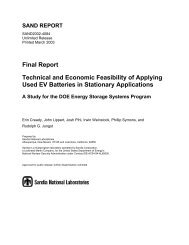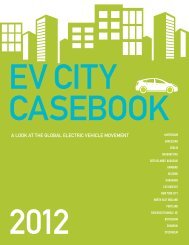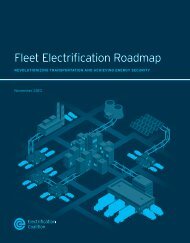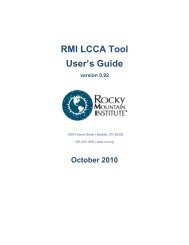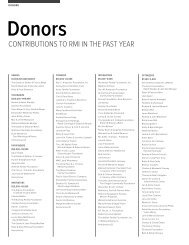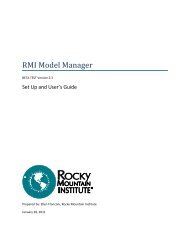Managing Deep Energy Retrofits - Rocky Mountain Institute
Managing Deep Energy Retrofits - Rocky Mountain Institute
Managing Deep Energy Retrofits - Rocky Mountain Institute
- No tags were found...
Create successful ePaper yourself
Turn your PDF publications into a flip-book with our unique Google optimized e-Paper software.
AcknowledgementsR. Peter Wilcox and John JenningsNorthwest <strong>Energy</strong> Efficiency AllianceThe RetroFit Depot guides to commercial building deepenergy retrofits were developed within the RetroFitInitiative of <strong>Rocky</strong> <strong>Mountain</strong> <strong>Institute</strong>. <strong>Rocky</strong> <strong>Mountain</strong><strong>Institute</strong>’s valued donors made this work possible.The <strong>Rocky</strong> <strong>Mountain</strong> <strong>Institute</strong> project team to producethe <strong>Managing</strong> <strong>Deep</strong> <strong>Energy</strong> <strong>Retrofits</strong> guide consistedof Elaine Gallagher Adams, Michael Bendewald, CaraCarmichael, Ellen Franconi, Molly Miller, Victor Olgyay,Roy Torbert, and Caroline Fluhrer Traube. The team isindebted to the following external reviewers:Mark FrankelNew Buildings <strong>Institute</strong>Peter Rumsey and Hilary PriceIntegral GroupDJ Hubler and Erin EllsJohnson Controls, Inc.Harry ConleySevenOaks Property ManagementHarvey Anderson and John RiceEssentia HealthDavid WilliamsLHB, Inc.Phil YuskaPerformance ServicesRic CochraneNational Trust for Historic PreservationLeslie LarocqueMcKinstryBill BrowningTerrapin Bright GreenRETROFIT DEPOT: MANAGING DEEP ENERGY RETROFITS ROCKY MOUNTAIN INSTITUTE 3
Au Proton 1.5 MeVo= 90 LFIGURE 4. Comparison of cross sections of M-shell electrons AB based on BEA theory with experimental resultsof gold target bombarded with 1.5 MeV protons.The yields of continuous X-rays in the energy region of 5-10 keV for each target can be explained by the BEAtheory. The behavior of BEA predictions in the high X-ray energy region is quite reasonable while the PWBApredictions overestimate the experimental data. This result shows that it is not necessary to introduce the idea ofprojectile charge screening effect in the process of atomic bremsstrahlung and necessitates improvements of thecalculation of the resonance terms in the T-matrix of AB.ACKNOWLEDGEMENTWe are indebted to Dr. V.A. Yardley for helpful discussion and critical reading of the manuscript.REFERENCESl. K. Ishii, S. Morita, and H. Tawara, Phys. Rev. A13 (1976) 131.2. F. Folkmann, C. Gaarde, T. Huus, and K. Kemp, Nucl. Instrum. Methods 116 (1974) 487.3. A. Yamadera, K. Ishii, K. Sera, M. Sebata, and S. Morita, Phy8. Rev. A23 (1981) 24.4. R. Anholt and T.K. Saylor, Phys. Lett. 56A (1976) 455.5. M.Ya. Amusia, Comments At. Mol. Phys. 1l (1982) 123.6. K. Ishii and S. Morita, Phys. Rev. A30 (1984) 2278.7. A.V.Korol, A.G.Lyalin, O.I.Obolensky, A.V.Salovyov, and I.A.Solovjev, J. Exp. Theo. Phys. 94(2002)704.8. K. Alder, A. Bohr, T. Huus, B. Mottelson, and A. Winther, Rev. Mod. Phy8. 28 (1956) 432.9. K.Ishii and S.Morita, Int. J. PIXE, 1 (1990) 1.10. K.Ishii, Radiation Physics and Chemistry 75 (2006) 1135-1163.11.K.Ishii,H.Yamazaki, S.Matsuyama, W.Galster, T.Satoh and M.Budnar, X-Ray Spectrum 34(2005)363-365.12. J.D.Garcia, Phys. Rev. A1 (1970) 280.13. K.Ishii and S.Morita, Japanese Journal of Applied Physcs, 17 Supplement 17-2, (1978) 374. where by mistakethe cross sections was multiplied by the factor 1/2.14. T.F.M. Bonsen and L. Vriens, Physica(Utr.) 47 (1970) 307.© Universidad Nacional Autónoma de México, 2007 B1 - 5
Why <strong>Deep</strong> <strong>Energy</strong> <strong>Retrofits</strong>?<strong>Deep</strong> energy retrofits provide attractive financial and business opportunitiesfor building owners, tenants, engineers, and architects alike. Since the 2008economic collapse, real estate owners have increasingly been looking forways to cut costs, retain tenants, increase market performance, and gaincompetitive advantage. <strong>Deep</strong> energy retrofits can achieve these objectivesby turning business-as-usual upgrades—normally unavoidable cost-sinks—into profitable investments.OPPORTUNITIES FROM DEEP ENERGY RETROFITS*OWNERSReduce costs; improve public relations, sales, andemployee health/productivityThe economic downturn also gives engineers, architects, and contractorstime to course-adjust their business strategy so when the market comesback, they are ahead of the competition. There is no time like the presentfor building professionals to retool, to rethink, and to retrain.At the same time, deep retrofits benefit society as a whole through thegeneration of new jobs, reduction in carbon emissions, and energy security.INVESTORSLANDLORDSIncrease market performance for a better yieldAttract and retain desired tenants; increase rent anddecrease vacancyNow, more than ever, the U.S. building stock is due for business-as-usualupgrades. According to the <strong>Energy</strong> Information Administration, one in threeU.S. commercial buildings are failing and in need of major renovations, offeringa unique window of opportunity for owners to not only get their buildingsback to working order, but also to make them significantly more efficientand valuable. Study after study reaffirms the large efficiency opportunitythat currently exists in the U.S., predicting that ~30% of commercial buildingenergy use could be cost-effectively cut by 2030 (McKinsey 2009, NAS2010). More recently, Amory Lovins and <strong>Rocky</strong> <strong>Mountain</strong> <strong>Institute</strong> predictedbuilding energy savings of 38–69% to generate $1.4 trillion in positive netpresent value by 2050 (Lovins & RMI 2011).The time to take advantage of this opportunity is now, which is why we haveprovided the following guide to help retrofit teams cost-effectively achievethe deepest savings possible.TENANTSSERVICEPROVIDERSSOCIETYBenefit from space that is more comfortable, satisfying,and productive for lower occupancy costsDifferentiate in a crowded building market, gain accessto larger projects and larger client base, and delivermore valueImprove economy with more jobs, reduce carbonemissions, and create energy security* Read more in the Building the Case GuideRETROFIT DEPOT: MANAGING DEEP ENERGY RETROFITS ROCKY MOUNTAIN INSTITUTE 5
how to use this GuideThe <strong>Managing</strong> <strong>Retrofits</strong> Guide provides a comprehensive overview of deepenergy retrofits for commercial buildings and a framework for implementingthem, with detailed process guidance for design/retrofit teams. Buildingowners, managers, and retrofit practitioners should use this guide to planand implement a deep energy retrofit for their building. The Guide shouldbe used in conjunction with the Building the Case Guide and IdentifyingDesign Opportunities Guide also provided on www.RetroFitDepot.org.The guide is a “desk reference” that is divided into several sections tomake it easier to find topics of interest. All the practices and approachesdescribed in this document are techniques used by leading real estateowners, managers, and retrofit practitioners.The optimal way to use this guide is to read it and circulate among otherbuilding stakeholders. After gaining a solid foundation of understanding,set up a meeting of stakeholders and begin the process. If you need moreguidance on your commercial building deep energy retrofit project, you maycontact <strong>Rocky</strong> <strong>Mountain</strong> <strong>Institute</strong>’s Built Environment Team at bet@rmi.org.At the end of each section in the deep energy retrofit framework are KeyAction Items, highlighted in green boxes as shown to the right. These boxessummarize the main recommendations that your organization can follow.Share these items with your senior decision makers and, as applicable, getthem involved with the deep energy retrofit project. You will also find <strong>Deep</strong><strong>Energy</strong> Retrofit Highlights in blue boxes that identify the unique aspects ofa deep energy retrofit.RETROFIT DEPOT: MANAGING DEEP ENERGY RETROFITS ROCKY MOUNTAIN INSTITUTE 6
Key Action Itemsfor <strong>Deep</strong> <strong>Energy</strong> <strong>Retrofits</strong>To fully achieve the benefits of deep energy retrofits,those implementing a deep energy retrofit shouldpiggyback efficiency improvements on already plannedcapital improvements and breaks in occupancy, takeadvantage of advanced energy modeling and life cyclecost analysis methods, verify savings and continuouslyimprove energy performance, and use the other practicesoutlined in this section.Key Aspects of a <strong>Deep</strong> <strong>Energy</strong> Retrofit Process are:<strong>Deep</strong> Retrofit TriggersIdentifying the situations in a building’s life cycle that should trigger a deepenergy retrofit design and analysisTechnical PotentialFinding the energy use that would result from implementing all of the mostcutting-edge efficiency measures possible and minimizing constraints toachieving itModelingDetermining energy and life cycle cost savings using advanced methodsand toolsRight-Timing & Right-SizingTiming efficiency improvements with already planned capital improvementsand breaks in occupancy; accurately sizing (not over sizing) mechanical andelectrical equipmentMeasurement & VerificationEnsuring achievement of savings while illuminating opportunities forcontinuous improvementThe following sections do not provide an exhaustive list of action items forany energy retrofit; rather, they highlight the items that are important for adeep energy retrofit. <strong>Deep</strong> energy retrofits may require more soft costs thanstandard retrofits, however the return can more than offset the difference.RETROFIT DEPOT: MANAGING DEEP ENERGY RETROFITS ROCKY MOUNTAIN INSTITUTE 7
<strong>Deep</strong> <strong>Energy</strong> Retrofit TriggersStop! Before moving forward with a deep energy retrofit, make sureyour manager has timed it appropriately. Certain situations are ideal forperforming a whole-building deep retrofit analysis—some of which arelisted below—because they can significantly improve both the economicsand convenience of planned energy improvements. Most circumstancespertain to the work actually done in or on a building itself, and each couldprove pivotal in improving returns from projects.DEEP ENERGY RETROFIT HIGHLIGHTDEEPRETROFITTRIGGERSIdentifying the situations in a building’s life cycle thatshould trigger a deep energy retrofit design andanalysisIt is very important to consider these “deep energy retrofit triggers” whenbuilding the case for deep energy retrofit, which is why we list them in theBuilding the Case Guide as well.TRIGGERAdaptive reuse ormarket repositioningEnd (or near end) oflife roof, windowor siding replacementEnd (or near end) oflife HVAC, lighting orother major equipmentreplacementUpgrades tomeet codeNew Acquisitionor RefinancingFixing an “energy hog”Major occupancychange<strong>Energy</strong> managementplanningOPPORTUNITYRedeveloping an existing building will require significant capital expense to which the cost of a deep retrofit would be incremental and likelysmall in comparison.Planned roof, window and siding replacements provide opportunities for significant improvements in daylighting and efficiency at small incrementalcost, providing the leverage for a deep retrofit that reduces loads and therefore the cost of replacing major equipment such as HVAC and lighting.Major equipment replacements provide opportunities to also address the envelope and other building systems as part of a deep retrofit. Afterreducing thermal and electrical loads, the marginal cost of replacing the major equipment with much smaller equipment (or no equipment at all)can be negative.Life safety upgrades may require substantial disruption and cost, enough that the incremental investment and effort to radically improve the buildingefficiency becomes not only feasible but also profitable.New acquisition or refinancing at historically low interest rates can put in place attractively financed building upgrades as part of the transaction,upgrades that may not have been possible at other times.There are buildings, often unnoticed, with such high energy-use or high energy-prices (perhaps after a major rate increase) that deep retrofits havegood economics without leveraging any of the factors above.A company or tenant moving a significant number of people or product into a building or major turnover in square footage presents a prime opportunityfor a deep retrofit, for two reasons. First, a deep retrofit can generate layouts that improve energy and space efficiency, and can create more leasablespace through downsizing mechanical equipment. Second, ownership can leverage tenant investment in the fit-out.As part of an ongoing energy management plan for a group of buildings, the owner may desire a set of replicable efficiency measures. Thesemeasures can be developed from the deep retrofit of an archetypical building.RETROFIT DEPOT: MANAGING DEEP ENERGY RETROFITS ROCKY MOUNTAIN INSTITUTE 8
Get StartedTo realize a truly deep energy retrofit, it is important tobegin by creating a set of project requirements, carefullyselecting a team, using Integrated Project Deliveryprinciples, and writing a contract that aligns the teamaround a shared vision for the project.SUMMARY OF KEY ACTION ITEMSSet up a meeting with key building stakeholders todiscuss project vision and objectivesOWNER PROJECT REQUIREMENTSOwner Project Requirements (OPR) is a set of criteria defined by an ownerbefore a design team is even brought on board. It can be a useful andpowerful tool if the owner actively helps draft it. Unfortunately, OPRs arefrequently written by design teams, with little input from owners, well into thedesign process and then only to fulfill a LEED credit or other requirement.The Whole Building Design Guide, a valuable green building design resource,offers guidance on creating an OPR. In addition to the extensive list of topicsoutlined in the guide, an OPR for a deep energy retrofit may include:Specifically define what skills and experience youare looking for in a team and issue a Request forQualificationsCreate a contract that correctly incentivizes the teamto achieve the project vision• Owner’s mission and vision for the project• Drivers and motivation for change• Financing constraints and targeted incentives• Project energy goals• Indoor air quality requirements• Potential allies or partners• Methods/tools to be used, such as energy andlife cycle cost analysis for integrative design(see Tools & Resources)• Measurement & VerificationRETROFIT DEPOT: MANAGING DEEP ENERGY RETROFITS ROCKY MOUNTAIN INSTITUTE 9
REQUEST FOR QUALIFICATIONSAn OPR should be incorporated into a Request for Qualifications (RFQ),a document that should carefully articulate the deep retrofit approachas defined in this guide. A team should be eager to do intensive anditerative design work that supports the owner’s mission and vision. Theteam members should have a “can do” attitude and be experienced withsustainable design.INTEGRATED PROJECT DELIVERYIntegrated Project Delivery (IPD) is a process that includes all stakeholdersin optimizing project design and implementation through synergisticcollaboration; it is an ideal method for tackling deep retrofits. IPD is typicallyused for new construction, but it has been successfully applied to a tenantfit-out; its key principles and elements are universally applicable to allbuilding types and projects that involve major building changes. Those keyitems are:CONTRACTWhether working with an ESCO or a more traditional design-build team, anowner should use a project contract as an opportunity to explicitly outlineincentives to maximize efficiency gains. A design-build team should berewarded for the energy and resources that it helps save, not the moneythat it helps spend. Performance contracting should not be limited to <strong>Energy</strong>Saving Performance Contracts (ESPCs).A key part of making a deep retrofit economical is right sizing the mechanicaland other equipment. In a contract, an owner should consider includingan indemnification clause for the mechanical and electrical engineers tospecify equipment that is just the right size (not larger). The common lineis, “No engineer is ever sued for designing a system that is too big.” Weneed to allow these professionals to right size the mechanical and electricalsystems, without fear of recrimination.• Early involvement of key participants• Shared risk and reward• Multiparty contract• Collaborative decision-making and control• Liability waivers among key participants• Jointly developed and validated goals• Analysis and integration of multiple building systemsFor more on Integrated Project Delivery, see AIA (2007) and Cohen (2010).For a case study on how IPD was used for a high performance tenant fit-out,see Bendewald et al (2010).RETROFIT DEPOT: MANAGING DEEP ENERGY RETROFITS ROCKY MOUNTAIN INSTITUTE 10
Design and AnalyzeCREATE THE BASELINE SCENARIOAn owner needs a reference point to be able to evaluate an efficiencyscenario. Such a baseline can be a less aggressive investment in efficiencyor it can be a business-as-usual scenario without any investment in efficiency.A business-as-usual scenario does have costs, though many retrofit projectteams fail to acknowledge that capital investment is required to maintainbasic building functionality or to achieve other non-efficiency-related goals.When developing a baseline scenario, a deep retrofit team should coordinatewith a project’s facility manager and should refer to building reports, suchas a facility condition assessment report, to identify realistic capital andoperating/utility expenses. These expenses should be projected five, ten, ormore years into the future and accounted for in the life cycle cost analysis.Will windows need to be replaced in ten years? Will lighting need to beupdated to comply with future regulations? Such predicted expendituresshould be quantified in the baseline case.SUMMARY OF KEY ACTION ITEMSEvaluate the existing building or speak with the facilitymanager to determine business-as-usual capital andmaintenance requirementsSchedule a process for evaluating the building forefficiency opportunities and informing stakeholdersIdentify specific efficiency opportunities usingthe Identify Design Opportunities Guide andother Tools & ResourcesCreate and evaluate retrofit scenarios that helpyou tell a compelling retrofit story to decisionmakers and/or other stakeholdersRETROFIT DEPOT: MANAGING DEEP ENERGY RETROFITS ROCKY MOUNTAIN INSTITUTE 11
BEnChMaRK anD sEt Goals<strong>Energy</strong> benchmarks elucidate how a building compares to others and serveas points of reference within sectors and groups of similar buildings. Themost common U.S. energy benchmark used today is the ENERGY STARrating calculated by ENERGY STAR’s Portfolio Manager.Once a building is benchmarked, one can set clear, shared, and ambitiousgoals. Goals should be quantifiable and may include a timeframe (e.g. 50percent of the goal will be met by 2015 and 100 percent by 2020). Goalsshould rarely be prescriptive (e.g. install solar photovoltaics) as this can leadto a suboptimal building with some green features. Instead, goals should beperformance-based, written using metrics such as energy use per squarefeet, which measures energy use intensity (measured in kBtu per square feetper year). As a project progresses, one should continually revisit the initialproject goals to ensure that a project is still on track. Project goals may beorganized in tiers, from whole-building goals down to single-system specificones. (Note that the project vision should have already been specified inthe Owner’s Project Requirements.)stRuCtuRInG GoalsVisiontier 1: Whole buildingtier 2: Multi-systemtier 3: single systemSustainability fl agship for the rest ofthe school districtMost energy effi cient school in thenationx kBtu/SF/yrxx% energy cost reduction from2010 utility billsEliminate perimeter heatingMaximum lighting powerdensity of x W/SFRETROFIT DEPOT: MANAGING DEEP ENERGY RETROFITS ROCKY MOUNTAIN INSTITUTE 12
IDENTIFY OPPORTUNITIESIn the opportunity identification step, a retrofit teamshould conduct an energy analysis, engage multiplestakeholders, define the technical potential of thebuilding, hold an innovation charrette, and definemultiple scenarios.Conduct an <strong>Energy</strong> AnalysisThe term of art for conducting an energy use analysis as part of a buildingretrofit is an audit. The American Society of Heating, Refrigerating and Air-Conditioning Engineers (ASHRAE) has defined three types of building energyaudits, which vary in rigor and detail. They range from a Level I walk-throughsurvey to a Level III detailed analysis of capital-intensive modifications (alsoknown as an investment grade audit, or IGA). For a deep energy retrofit,complete an investment grade audit because it produces data with a levelof confidence necessary for major capital investment decisions.For detailed instruction on conducting an energy analysis for a deep energyretrofit, see the Identifying Design Opportunities Guide.Engage StakeholdersMultiple stakeholders beyond the building owner and service providercan contribute value during a deep energy retrofit project. Tenants,maintenance personnel and facilities operators, customers, utilities, andlocal governments can all potentially provide input to your efforts.It is critical to engage tenants because over half of the total energysavings in a tenant-occupied building retrofit can come from retrofittingtenant spaces. There are many potential efficiency measures that requireoccupant participation. Thus, unique tenant incentives should be created toencourage operational efficiency. It is also worthwhile to explore innovative,“green” leasing options that overcome tenant-owner split incentives. Finally,occupants should be surveyed both before and after the retrofit. This willensure occupant comfort goals have been met and that occupants areaware of and involved with the retrofit.Maintenance personnel and facilities operators are key to achieving theoperating reduction goals. These parties, whether they are in house staff oran external property management company, should be intimately involvedin any building upgrades from the beginning, so they can help form theenergy reduction goals, understand them and be more engaged to helpachieve them.Utilities should also be made aware of a deep retrofit, especially if one isretrofitting multiple buildings within their service area or jurisdiction. Evenif current utility programs don’t have incentives or rebates that match thecurrent project, they may be able to develop a custom incentive.Local government programs may also offer free audit or design assistservices, and local government officials can provide valuable assistance inthe interpretation of prevailing building codes, regulations, and initiativesthat may impact the project.It is important to identify and engage leaders of special interest groups,early and often, to elicit buy-in of potential solutions. It is critical to exposeany potential roadblocks early on and for everyone to work together tocreate a clear pathway.RETROFIT DEPOT: MANAGING DEEP ENERGY RETROFITS ROCKY MOUNTAIN INSTITUTE 13
Define technical potentialThe technical potential of a building is the energy use that would resultfrom implementing all of the most cutting-edge efficiency measurespossible, given today’s technology, without regard to financial or otherrestraints. The design team should assess the building’s technical potentialearly on in the design process because efficiency ideas are often limitedby preconceptions about cost, schedule, operational disruption, andconstructability constraints. Temporarily removing these constraints fromthe picture, allowing the team to solve problems without any inhibitions, canoften lead the team to cost-effective and practicable solutions it otherwisewould not have considered.The technical potential first sets the high bar for what is technicallyachievable in building performance. As shown below, the team can quantifyand document how specific constraints start to push the targeted level ofsavings away from the technical potential. In order to minimize this effect,the team should then identify what conditions would be necessary tomove back toward the technical potential, in order to reach the achievablepotential. Such lessons can inform future retrofits of the building at hand aswell as other buildings in the owner’s portfolio.Building <strong>Energy</strong> Use Technical PotentialDEEp EnERGy REtRofIt hIGhlIGhttEChnICalpotEntIalFinding the energy use that would result fromimplementing all of the most cutting-edge efficiencymeasures possible and minimizing constraints toachieving ithold an Innovation CharretteMany design and strategic challenges can best be solved through anintensive, highly integrative, transdisciplinary innovation workshop, orcharrette. A charrette brings together stakeholders and experts at the veryoutset of the process for small and large group brainstorming, discussionand converging on synergistic solutions. In RMI’s experience, this approachyields an ambitious design product, typically conceptual, with someextension into early schematic design.The innovation charrette during a deep energy retrofit provides anopportunity to engage multiple stakeholders, to introduce them to the ideaof the “technical potential,” and generally to get the project off to an excitingand effective start.2Annual <strong>Energy</strong> Use<strong>Energy</strong>EfficiencyMeasuresConstraints4135Current <strong>Energy</strong> Use Technical Potential Achievable PotentialRETROFIT DEPOT: MANAGING DEEP ENERGY RETROFITS ROCKY MOUNTAIN INSTITUTE 14
CREATE SCENARIOSOnce most necessary data is available and innovativeideas are on the table, it is time to analyze whichcombination of measures can provide the greatestvalue. To do so, evaluate individual as well as bundledmeasures, consider the long-term implications of suchmeasures, and tell a compelling story of the process,outcomes, and lessons learned. Present at least onerecommended efficiency improvement scenario thatmaximizes energy efficiency within one or more years.Use life cycle costing metrics such as net present valueand internal rate of return to report the expectedfinancial outcomes.DEEP ENERGY RETROFIT HIGHLIGHTMODELINGDetermining energy and life cycle costsavings using advanced methods and tools.Find out how.Evaluate Bundled MeasuresThe first step is to transform ideas regarding technical potential intoachievable potential options. Once execution of potential measures isbetter defined, each measure can be individually entered into an energymodel to determine its impact on annual energy savings, peak electricitydemand, and cooling and heating loads. Estimate the capital costs of themeasures as well, taking care to estimate the interactive effects betweenmeasures.Proper financial analysis and digging into cost estimates is just as importantas correct technical engineering analysis for a project. Capital cost estimatesshould always be vetted. Sometimes cost estimators misprice systems oroverprice them if they sound overly complicated. Having the design teamspend more time helping the cost estimator understand the design andexpected equipment (reduced) sizing can help lower cost estimates.Using the knowledge gained from modeling the energy savings and costof individual measures, teams should create bundles of measures that formvarious investment options for the decision-maker. Consider developingbundles of measures that achieve specific client objectives. We recommendidentifying a few different bundles, such as those that highlight expectedimprovement in worker satisfaction and retention, and those that areoptimized specifically for other client objectives.It is also possible to focus on the life cycle costs of individual measuresto create one bundle that maximizes net present value and another thatmaximizes energy savings. These bundles will give some bounds to thecost effectiveness of the project.Creating bundles is an iterative process because energy savings changebased on which measures are bundled together, which may also affectcapital costs. In creating the bundles, it is also important to consider nonquantifiablebenefits and the sources of uncertainty 2 .2For a complete discussion of how to consider and present value and uncertainty, see the Building the Case Guide.RETROFIT DEPOT: MANAGING DEEP ENERGY RETROFITS ROCKY MOUNTAIN INSTITUTE 15
Right Time and Right SizeWhen bundling measures, it is also important to develop an implementationtimeline that may be immediate or several years. In doing so, incorporatefour main elements into the plan:1. Alignment with equipment replacement cycles. Better alignment withplanned replacements will minimize the retrofit’s marginal cost. Forexample, the efficient air-handling units for the Empire State Buildingretrofit were installed at the same rate over several years as what wasplanned for the code-compliant air-handling units. If they are installed ata faster rate, the marginal cost of the units would be higher.2. Occupant disturbance. Tenant or occupant turnover provides an idealtime to implement measures. Alternatively, work could be completed onnights and weekends, but labor will cost more.3. Sequence of construction. Implement electrical and thermal loadreducingmeasures first. This way, you won’t have any problems whenyou install your right-sized (not over-sized) new equipment.4. Budgeting. It might be necessary to budget for smaller expendituresover several years as opposed to one large sum during one year.DEEP ENERGY RETROFIT HIGHLIGHTRIGHT-TIMING&RIGHT-SIZINGTiming efficiency improvements with alreadyplanned capital improvements and breaks inoccupancy; accurately sizing (not over sizing)mechanical and electrical equipmentCreate Pathway to Very-Low or Net-Zero <strong>Energy</strong> UseDuring or after bundling measures, it is also important to consider the longtermenergy goals for a building. While you may decide that upgrading abuilding’s systems with certain technologies is currently too expensive,such measures may be ideal retrofit solutions a decade down the line.Moreover, a pathway to very-low or even net-zero energy use is notnecessarily a scenario that needs to be presented to a decision-maker forconsideration for current investment, but it is helpful to the owner to have ahigh-level plan that illustrates how decisions made today will impact goalsset down the road.RETROFIT DEPOT: MANAGING DEEP ENERGY RETROFITS ROCKY MOUNTAIN INSTITUTE 16
TELL A COMPELLING STORYAt the conclusion of the analysis stage, it is important to develop a clearand compelling story about the opportunity and the resources required tocapture it. Such a narrative will help sustain momentum moving into theexecution phase, provide a consistent set of messages to discuss on otherprojects, and will provide strong marketing material that documents theincreased value of—and future opportunities for—the building.It is quite likely that you will have made numerous discoveries aboutthe building, its operation, the cost of implementation, and options forimprovement. As such, this is the point at which an decision-maker willconsider the opportunities and risks of moving ahead with the project.Make sure you are well equipped to address risk, or the uncertainty aboutthe project. How confident are you that the building will hit the predictedenergy savings? How can you best describe your level of confidence to theowner?For more on how to discuss risk and create a compelling storyline for adeep energy retrofit, see the Building the Case Guide.RETROFIT DEPOT: MANAGING DEEP ENERGY RETROFITS ROCKY MOUNTAIN INSTITUTE 17
Implement the MeasuresThe implementation phase realizes the specificefficiency scenario selected by the decision-maker.Careful attention to construction and commissioningduring the process will improve the profitability andoverall outcome of a deep retrofit project. In addition,Measurement & Verification will ensure savings areachieved and address any issues.Quality construction and commissioning is key toensuring that all of the effort expended on a design isexecuted properly. Too frequently, a lack of coordinationbetween a designer and builder leads to constructiondelays and additional project costs. By contrast, aninclusive approach that receives input from contractorsand commissioning agents early in a design process, andcoordinates efforts throughout the construction period,can significantly reduce the likelihood of such issues.SUMMARY OF KEY ACTION ITEMSEnable close collaboration between design andconstruction staff through routine meetings; consideradvanced tools for communicatingdesign informationSecure a commissioning agent for the retrofitproject early in the design process to inform thedesign and ensure it is constructed and operatesappropriatelyEnlist the commissioning agent or another serviceprovider to create and implement a Measurement &Verification PlanRETROFIT DEPOT: MANAGING DEEP ENERGY RETROFITS ROCKY MOUNTAIN INSTITUTE 18
CONSTRUCTIONA retrofit is most successful when designers and builders attempt tocoordinate their efforts as if they are a single entity. One coordination strategyis to “co-locate” during design and construction. That is, a representative ofthe builder works out of the designer’s office for a few days during design,and vice versa during the construction phase.Another strategy is to use building information modeling (BIM) or anothertype of building model to examine where new building components mightspatially conflict (a surprisingly common occurrence) and to produce 3Dimages of building details that, when provided on the jobsite, help buildersvisualize what they are constructing. Pre-fabrication of building components(such as ductwork) can also be employed to reduce the chance of onsiteconstruction errors.COMMISSIONINGCommissioning a building is another critical element of the deep retrofitprocess. When implemented properly, commissioning is an intensive qualityassurance process in which a third-party commissioning agent providesoversight not only during construction, but also during the design phaseand then later through occupancy and operations to ensure the projectmeets defined objectives and criteria.A commissioning agent may help define objectives and criteria, provideperiodical design reviews, offer insight into constructability or controlstrategies, and/or develop operations manuals and training procedures.During construction, an agent will ensure that systems and equipment areinstalled and operating according to design through on-site inspectionsand tests. After construction, the agent may also facilitate an onsite ownerarchitect-contractorbuilding walk-through immediately after construction inorder for the owner or facility manager to get a visual understanding of thesystems in place. Finally, the agent may ensure that operators are trained.The benefits of commissioning can be extended indefinitely byincorporating a regular commissioning program into a facility’s ongoingenergy management plan.MEASUREMENT & VERIFICATIONOnce constructed and commissioned, the deep energy retrofit will beginsaving energy. Now is the time to implement Measurement & Verification(M&V) to ensure the building will continue to save what was anticipated, andpossibly more.Equipment defects that emerge after passing the initial commissioning test,and uninformed occupants or ill-trained facilities staff can undo the bestbuilding design. M&V is a formalized process for diagnosing and addressingthese issues. As an added benefit, measured building energy use data canbe used to confirm (and sometimes correct) utility billing and can then becommunicated to occupants in the form of a wall display or energy bill aspart of an energy management plan providing feedback to further reduceenergy use. Also, ongoing M&V provides opportunities to continuallyimprove equipment performance through better control strategies.DEEP ENERGY RETROFIT HIGHLIGHTMEASUREMENT&VERIFICATIONEnsuring achievement of savings whileilluminating opportunities for continuousimprovementOwners should begin the M&V process during the opportunity identificationphase of a retrofit to guarantee that the design team appropriately specifiesmetering equipment and develops an M&V plan. An M&V plan outlines theobjectives, responsible parties, metering points, data-handling methods,baselines, performance adjustment parameters, savings calculation options,and other procedures associated with the process. As such, M&V shouldonly occur once the project has already been constructed, commissioned,occupied, and reached a state of steady operation. The process shouldalso be carried out according to industry-accepted standards defined bythe Efficiency Valuation Organization (2009).Once operation is stable for at least a year, the M&V team will determineenergy savings on a system level through calibrated spreadsheet analysisor on a building level through calibrated whole-building simulation analysis.The level of detail and rigor followed are outlined in the M&V plan andshould be correlated to the risk and value of the savings that are to bequantified. If actual performance lies below the specified range of predictedperformance, all stakeholders should understand who is contractuallyresponsible for remediation.RETROFIT DEPOT: MANAGING DEEP ENERGY RETROFITS ROCKY MOUNTAIN INSTITUTE 19
Challenges and OpportunitesA deep energy retrofit results in an efficiency upgradeplan that can extend several years into the future andacross other facilities with similar building systems. Amain challenge is that energy and maintenance costsavings do not always justify such an investment.Two approaches can significantly improve the economics of a deep energyretrofit. The first is taking into account the avoided costs of replacementsand upgrades that must occur as part of ongoing capital improvements.The second is to consider benefits such as tenant attraction and retention,occupant productivity and performance, and community stature, amongmany others. A complete list of potential value is provided in the Buildingthe Case Guide.To fully understand the potential value of the deep energy retrofit on aparticular project, retrofit practitioners should collaborate fully with facilitymanagers. Facility managers have a long list of work objectives, which theyoften do not provide to the energy professional during an energy auditunless requested (often because they do not want to influence the energyprofessional’s recommendations).At first glance, a facility manager’s objectives may seem at odds withefficiency renovations, or in competition for funding. However, a deepenergy retrofit that is completed as part of a comprehensive renovationcan identify opportunities that achieve both objectives for a single cost.Facility managers must therefore express their full range of objectives andconcerns to the energy professional, who can then design solutions thatmeet the objectives at least cost.In addition to identifying solutions that meet facility manager objectives,the deep energy retrofit process will reveal ways to piggyback measuresonto planned building equipment or component replacements—therebyreducing the cost and inconvenience of standalone efficiency measures.A well-planned deep retrofit project can identify several piggybackingopportunities that are not necessarily straightforward. Only the deliberateand rigorous process of a deep retrofit can identify these opportunities thatmake efficiency more cost effective and valuable.RETROFIT DEPOT: MANAGING DEEP ENERGY RETROFITS ROCKY MOUNTAIN INSTITUTE 20
In ConclusionPerforming deep energy retrofits across the U.S.building stock makes sense now, more than ever,because the industry is ready, buildings are ripe, andsuch renovations are profitable.With enough commitment and vision, building owners can use this andother RetroFit Depot guides to take advantage of this unique opportunityand reap the many benefits afforded by deep energy retrofits. Businessescan become more competitive, profitable, and resilient by leading thetransformation of our building stock that is largely inefficient. This transitionwill build a stronger economy, a more secure nation, and a healthierenvironment.We welcome your feedback. Your experiences and observations arevaluable to the continued development of the RetroFit Depot website. Thejourney is just beginning, and we look forward to hearing from you.<strong>Rocky</strong> <strong>Mountain</strong> <strong>Institute</strong>Built Environment Teambet@rmi.orgRETROFIT DEPOT: MANAGING DEEP ENERGY RETROFITS ROCKY MOUNTAIN INSTITUTE 21
ReferencesAmerican <strong>Institute</strong> of Architects (AIA). 2007. Integrated Project Delivery: AGuide. www.aia.org/contractdocs/AIAS077630. Washington, DC: American<strong>Institute</strong> of ArchitectsBendewald, Michael, Lionel Bony, Cameron Burns, Lindsey Franta, AmoryLovins, Alok Pradhan. 2010. Autodesk AEC Headquarters and IntegratedProject Delivery: A Factor Ten Engineering Case Study. http://rmi.org/rmi/Library/2010-16_AutodeskCaseStudy. Snowmass, CO: <strong>Rocky</strong> <strong>Mountain</strong><strong>Institute</strong>.Cohen, Jonathon. 2010. Integrated Project Delivery: Case Studies.Sacramento, CA: AIA California Council.Efficiency Valuation Organization (EVO). 2009. International PerformanceMeasurement and Verification Protocol (IPMVP) Volume I. Washington, D.C.:Efficiency Valuation Organization.Lovins, Amory and <strong>Rocky</strong> <strong>Mountain</strong> <strong>Institute</strong>. 2011. Reinventing Fire: BoldBusiness Solutions for the New <strong>Energy</strong> Era. White River Jct., VT: ChelseaGreen Publishing, 2011.National Academies of Science (NAS). 2010. Real Prospects for <strong>Energy</strong>Efficiency in the United States. Washington, D.C.: The National AcademiesPress. Retrieved February 7, 2012 from http://www.nap.edu/catalog.php?record_id=12621#orgs.McKinsey & Company. 2009. Unlocking <strong>Energy</strong> Efficiency in the USEconomy. Chicago, IL: McKinsey & Company. Retrieved February 7, 2012from http://www.mckinsey.com/Client_Service/Electric_Power_and_Natural_Gas/Latest_thinking/Unlocking_energy_efficiency_in_the_US_economyRETROFIT DEPOT: MANAGING DEEP ENERGY RETROFITS ROCKY MOUNTAIN INSTITUTE 22



